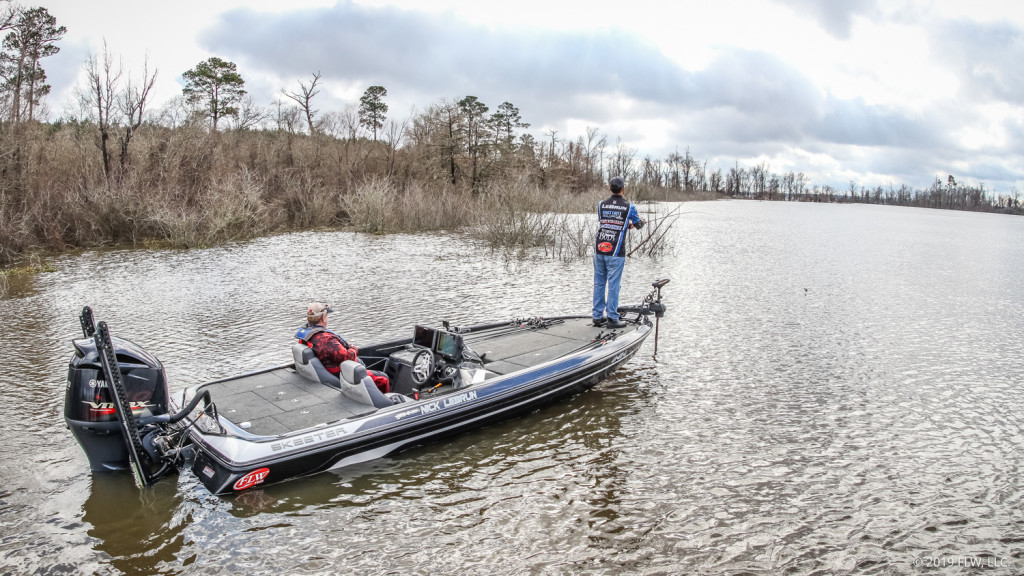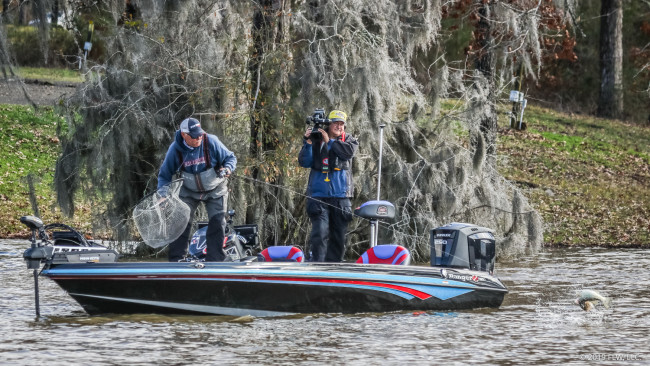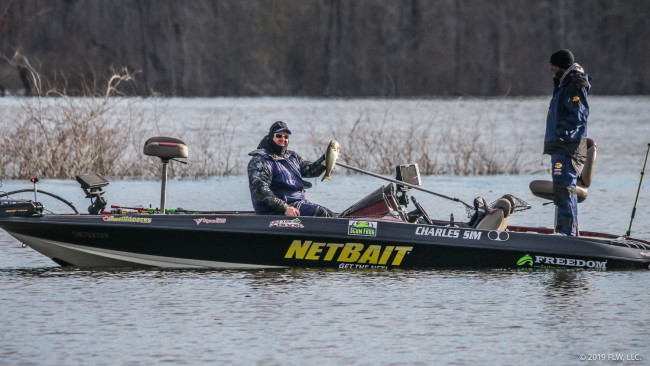Top 10 Patterns from Sam Rayburn
It was all about grass on flooded Big Sam

Terry Bolton went wild on day two of the FLW Tour opener presented by Polaris on Sam Rayburn Reservoir with a behemoth 33-pound, 9-ounce stringer of giant largemouths en route to a 12-ounce victory over rookie standout Nick LeBrun. The tournament was notable for many reasons, not the least of which included abnormally high water levels and disruptive winds that churned up waves and forced the top 10 anglers to compete for the $125,000 top prize on Monday following a one-day postponement.
Bolton sacked 91-3 to outpace the rest of the field, and he did so fishing deep-diving crankbaits around grass. Nearly everyone in the final 10 did something similar. Here’s how it all went down.

2. LeBrun spins up a blade
Rookie Nick LeBrun caught the biggest bag of his life on day one (29-2), and he did it by virtue of exploiting the same pattern in three or four productive spots. The Bossier City, La., pro knows Big Sam well. He lives just a couple hours away, and he had plenty of time to pre-fish the reservoir before it went off limits to Tour pros.
Unfortunately, the fish LeBrun found at the time came on a Bill Lewis Rat-L-Trap that was nearly impossible to fish effectively during the tournament due to water levels more than 10 feet above full pool. Fortunately, LeBrun had a backup plan for reaching those fish that included Strike King 5XD crankbaits and a custom prototype V&M spinnerbait they’ve dubbed “the Big LeBoom.”
LeBrun went as far west as anyone not named John Cox (who went as far up the lake as possible to find some skinny water) to find his fish, setting up shop north of the 147 bridge on a spot he found to have his perfect recipe for catching big fish.
“I had six or seven spots, but really only three or four were consistent,” he explains. “You have an inside grass line, and sometimes the grass grows all the way to the bushes. [In that case] you’re going to catch little ones. If you can find a spot where the grass stops and there’s a void and there’s kind of a hard bottom before it gets to those bushes, that’s where the big ones are.”
Though LeBrun did plenty of damage with a blade in hand by the time the dust had settled, that bite wasn’t on early.
“I only had one big one on the spinnerbait on day one, but that bite kind of evolved as the tournament went on,” he says. “Day two I struggled, and I figured out that the spinnerbait would catch a big one if I needed it to. So I kind of kept it in my hand more.”
LeBrun also found spots with the perfect recipe of grass and hard-bottom voids south of the 147 bridge, just off Bird Island, and farther down the lake in Harvey Creek.
3. Thrift drags around a rig
There isn’t a technique Bryan Thrift doesn’t enjoy using if it catches him some fish. This week, that technique was dragging a Carolina rig in areas with a lot of grass.
Thrift set up shop in Veach Basin on the northern portion of the lake, near the midway point, and did most of his damage in that location. He employed a Carolina rig with a Zoom Brush Hog in green pumpkin color, as well as a 5 1/2-inch Damiki Stinger stick worm. On the final day of the event, Thrift also broke out a Strike King 6XD to expand on the area he fished fairly thoroughly during the first three days.
“I was targeting grass lines and some bare spots in the grass,” he explains. “Most of it was grass lines where the grass had a nice defined edge.
“There were scattered patches of grass out there. There was a grass edge that I caught most of my weight on Saturday and today [Monday]. I kind of tried to expand on it, and I caught a couple of my bigger fish today on the crankbait just out around some scattered clumps by the main place I was fishing.”
Like LeBrun, Thrift bounced around to some other areas that had just the right amount of grass and bare spots, but most of his 88 pounds, 13 ounces of fish came from that spot at the mouth of Veach.

4. Warren ventures off the beaten path
Chad Warren missed a portion of the official practice period due to illness, and he was left with just a few fruitful spots when it came time to fish when it mattered.
It worked out pretty well for him. A fourth-place finish and a four-day total of 83-13 are proof enough.
Because Warren lost time to scout out grass and structure, he settled on just three spots for the whole tournament. Each spot was west of the 147 bridge, and none of them was entirely dependent on how much grass was in the area.
“I fished the same three spots all four days,” he says. “One spot I found is a hard spot where the waves and stuff over time have made a little ledge. The other two spots I fished were just channel swings where a channel made a swing tight to the bank, and those fish are stacking up. They’re pulling up out of the ditch and sitting on that edge right between the grass and the bushes, and there’s a little void right there.”
Warren employed a white swim jig to land all 25 pounds, 7 ounces of the fish he weighed in on day one, but he turned to a Strike King 5XD crankbait and a wacky-rigged Yamamoto Senko with a nail weight, Neko-rigged, on day four to land 23-2 en route to his fourth-place finish.

5. Tutt keeps it simple
Jim Tutt has fished Big Sam enough to know that sometimes simplicity is the best approach. He fished just a handful of spots on the same portion of the lake with mostly one bait to bag 78-7 total.
“My pattern was I fished six spots,” Tutt says. “One was a little point. Two of them were little bitty ledges that were the old bank line. There were clay banks that had about 3-foot drops. One had a little piece of concrete on it. That was it. I just rotated. I didn’t run and gun. I was meticulous. I’d make 100 casts, and pretty soon I’d catch two or three. Sometimes, like today [Monday], on 15 casts in a row I’d catch one each cast.”
Tutt’s spots were almost all in Harvey Creek, though he did mix in a spot above the 147 bridge.
“My boat was sitting in 11 to 12 feet, and I was throwing to like 8,” he explains. “Every spot was the same. I fished around the bridge area, Harvey creek, and one of my main spots was above the bridge. The rest of them were in Harvey around the bridge area.”
The 58-year-old Rayburn vet kept it simple with his baits as well. Aside from one fish he caught on a Texas-rigged lizard and one on a jerkbait, Tutt caught all his fish on a Berkley Bad Shad crankbait and 10-pound-test Gamma fluorocarbon line.

6. Schrumpf keys in on points
Unlike most of the anglers who made the top 10 at Rayburn, Highland, Ill., pro Colby Schrumpf wasn’t looking for areas with a lot of grass and a bunch of voids within it. He wasn’t even looking for grass lines with sharp edges. All he wanted was a point with a pocketful of green stuff.
“In the areas where I was catching them on those points there was probably grass the size of a wheelbarrow – I mean, nothing,” he says. “That’s what held those fish there. They were on pinpoint little spots. I was fishing tight to the shore on the old water line. That was key. It was really sparse, but that’s what held all those fish.”
Schrumpf fished his way to 70 pounds, 7 ounces for the tournament by throwing medium-diving crankbaits, specifically a Bandit 300 Series and a Bomber Fat A, both of which dive about 10 feet. He added a couple key fish on a finesse worm on a shaky head, but he knew exactly what he wanted to do by the time he arrived for practice.
“At practice the first day I got on a crankbait bite right away,” he adds. “I had it tied on before I even left the house. I anticipated cranking grass. I just didn’t know how deep it was going to be. I just continued to run that type of pattern.”
What made the difference for Schrumpf, he says, is knowing where he could fill out a limit before swinging for the fences.
“Mainly I was fishing back in Harvey Creek, and I had one stretch back there that was somewhat point-related, but I probably caught 30 or 35 keepers off that particular stretch. I could get there every morning and catch a limit pretty comfortably and then start bouncing around and culling up. It seems like everything I caught fish on was definitely point-related. I had a couple key ones out on the main lake that would reload for me every day, so I was able to get a couple key culls every single day off a couple different points, and that made a big difference.”

7. Osborne’s honey hole
Fourth-year Tour pro Jordan Osborne had every intention of rotating through a half-dozen spots in pursuit of Big Sam giants. Instead, he stayed close to his primary spot and landed all his key fish from it.
“Day one I started off in a drain that drops off. It’s basically a traditional spawning flat down here; a little drain that’s in about 10 feet and drops down to 20 or 25 feet,” he explains. “I was dragging and cranking down that drop, catching most of those fish right there off that outside grass edge on a Carolina rig and magnum soft jerkbait by Bass Pro Shops in a Houdini color or a Yamamoto Senko in a chartreuse color, and then I would follow up with a Strike King 6XD crankbait in a shad pattern.”
The big problem, Osborne says, is that his honey hole – at which he caught 50 fish by 10 o’clock on day one – was his only productive spot, and if he was to protect it from local and tournament fishing pressure, he needed to guard it. By the time day four arrived, it just wasn’t productive enough to justify staying all day.
“I had four or five spots that I felt like I could rotate through, and when I did have a chance to leave my main area, I would go try those areas and I wouldn’t get bit,” Osborne adds. “It was really kind of bothering me that I only had one spot to catch fish. Today [Monday] I spent until about 10:30 on that main spot and fished stuff I hadn’t fished all week. I needed something special to happen.”
Osborne did identify one key point that could have made a huge difference had he been able to vacate his best spot more regularly. He says the key depth range for catching fish off grass edges was approximately 14 feet of water.

8. Redington goes for broke on day four
Tom Redington worked the same area for three days before swinging for the fences in new areas on the final day of the tournament. It didn’t quite work out as he would have hoped, bagging just 12-13 on day four, but his 67-10 total was good for eighth place and a $16,000 payday.
Redington, like much of the field at Rayburn, keyed in on grass lines to find his best fish. He opted for finesse tactics after failing to get many bites on moving baits. A drop-shot became his best friend by the time it was all said and done.
“The second day … that’s where the drop-shot became a big player,” he explains. “I was using a 1/2-ounce sinker and 10-pound Berkley Trilene 100% Fluorocarbon and a Havoc Bottom Hopper in green pumpkin red. That became a hammer for days two and three. Almost all my fish came on that. I could keep the school fired up with it. I culled through so many fish to get the right ones.”
Redington found some highly productive grass to exploit throughout the event. He compared the behavior of Rayburn’s largemouths to that of postspawn and summertime fish, which often school up on key locations. His best spots were outside the edge of the grass, rather than up on the flat.
“I fished little ditches that led into spawning areas, and I was just working backward,” Redington explains about how he located the spots. “I tried the wood, and they weren’t up there, so I knew they were staging. I was looking where the grass started – the deepest grass I could find – or along the drains where the grass would grow out to the edge of the creek where the grass started and stopped.”

9. George finds some gravel
Tour rookie Sam George found a “magic little place” off a point and milked it for the entirety of the tournament to the tune of 67 pounds, 10 ounces, 28-5 of which came on day one, finishing the day just shy of the lead held by LeBrun.
That magic place was a high spot on a point with some pea gravel surrounded by grass. The area was just 30 feet by 30 feet, but it was big enough to hold a bunch of quality fish for George to hammer on.
“I kept it honest this week,” he says. “I tried fishing up in the woods. I tried fishing grass. Anytime you’re fishing grass, you’ve got to find something different, like a clean spot or a patch of gravel or a ditch turn or a drain. That’s usually what those fish relate to. It [the magic spot] did have grass around it, but that gravel was clean. It would be pretty fast and furious for an hour or two in the morning, and after that they pulled back off and got into that deeper grass and got a lot harder to catch.”
George believes the “local advantage” many anglers might have otherwise had at Rayburn went out the window with high water levels, mostly because fish were still hanging around their normal prespawn and wintering holes but with an extra 10 feet of water overtop of their heads. Instead of a Rat-L-Trap tournament, Rayburn turned into a slugfest centered on the ability to adapt to the conditions and still catch fish.
George certainly did that. He just didn’t quite have enough fish in his best spot.
10. Sim parks in one spot for four days
One of just two Canadian anglers on Tour this year, Charles Sim drove 28 hours from Nepean, Ontario, to bust on some east Texas largemouths and earn his first top 10 on Tour. And after driving more than a full day to get to Rayburn, it’s no surprise he didn’t feel like moving much once he got there.
“My boat was within 20 feet for probably 90 percent of the fish I weighed in,” Sim says.
The reason Sim could sit on the same spot for four days of competition was simple: It was loaded with fish.
“I was in a little drain that was leading back to a spawning area, and I think they were staging there,” he adds. “They were really grouped up tight on this one bank with a straight drain with a tiny little turn. It didn’t jut out more than 10 feet, but on that 10-foot spot there was a big chunk of hydrilla and they were sitting on that.”
Sim tossed around a Texas-rigged NetBait Paca Craw for a couple fish and a Carolina-rigged NetBait Mad Paca for some others, but most of his bass came on a Strike King 6XD in powder blue back chartreuse color.
Making a top 10 in a tournament full of hammers by virtue of working one spot for four days isn’t easy, and Sim certainly got the most of his honey hole for a $14,000 payday.

